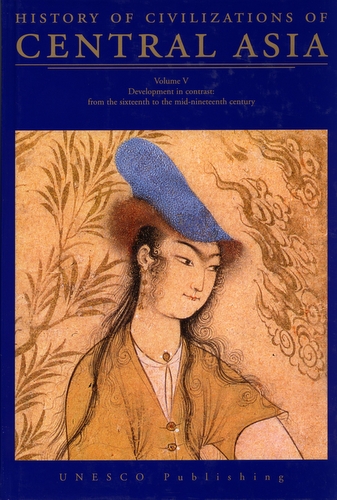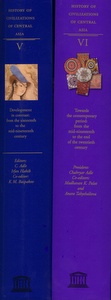History of Civilizations of Central Asia
Volume V - Development in contrast: from the sixteenth to the mid-nineteenth century
The multi-volume History of Civilizations of
Central Asia is the first attempt to present a
comprehensive picture of this subject. The publication of this
work falls well within UNESCO's terms of reference since the
underlying research was conducted by a distinguished
international team of specialists which for many years laboured
in harmony at the task of presenting to a wider public the
civilizations of this vast area located at the heart of the
Eurasian continent. The volumes will reveal the cultures that
flourished and vanished in this area, from the dawn of
civilization to the present time. Only a few names such as
those of Samarkand, Bukhara or Khiva, are familiar to a wider
public; eminent specialists, many of them native to the region,
now lift the curtain to reveal a richer, more varied
civilization. To a great extent, the history of the ancient and
medieval world was shaped by the movements of peoples in this
heartland of Eurasia, stretching from the Caspian Sea in the
west to the borders of China proper in the east.
Editors:
Chahryar Adle
Irfan Habib
Co-Editor:
Karl M. Baipakov
Summary:
This volume continues the history of Central Asian
civilizations from c. 1500 to c. 1850, a
period which saw the last medieval empires, notably the Uzbeks,
Safavids, Mughals and Dzungars, and witnessed the early impact
of colonialism. Like the preceding volumes, the present one
also deals with all the diverse elements of culture. It
describes the last phase of nomadism as a viable system of
social organization; the effects on Central Asian economies of
the shift of the main lines of international trade from the
Great Silk Route to the oceanic routes; the various schools of
art; the last great age of classical Persian literature and the
growth of Turkic literatures; and, finally, in the religious
sphere, the Shi`ite triumph in Persia, the conversion of the
Mongol peoples to Buddhism, and the rise of Sikhism. It also
analyses the problem of the lag in Central Asian scientific and
technological development in relation to Europe and the nature
of early colonialism – notably British and Russian – in Central
Asia. The conclusion sums up the main trends in Central Asian
history from the sixteenth to the mid-nineteenth century.



